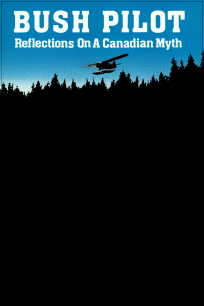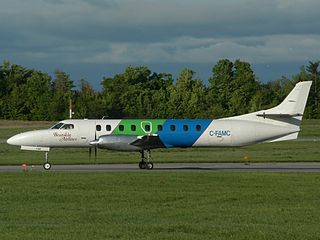
Bearskin Lake Air Service LP, operating as Bearskin Airlines, is a regional airline based in Thunder Bay, Ontario, Canada. It is a division of Perimeter Aviation and operates services in northern Ontario and Manitoba. Its main base is at Thunder Bay International Airport (YQT), with a hub at Greater Sudbury Airport (YSB).
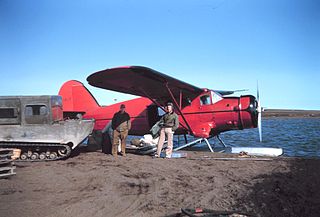
Bush flying refers to aircraft operations carried out in the bush. Bush flying involves operations in rough terrain where there are often no prepared landing strips or runways, frequently necessitating that bush planes be equipped with abnormally large tires, floats, skis or any other equipment necessary for unpaved runway operation. It is the only viable way of delivering people and supplies into more difficult to reach, remote locations.

The Noorduyn Norseman, also known as the C-64 Norseman, is a Canadian single-engine bush plane designed to operate from unimproved surfaces. Distinctive stubby landing gear protrusions from the lower fuselage make it easily recognizable.

Lamb Air Ltd. was a Canadian airline that began operations in 1934 in The Pas, Manitoba, and went out of business in 1981.
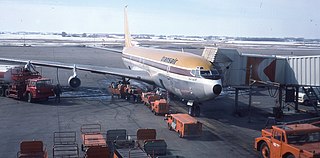
Transair was an airline based in Canada. It was purchased by Pacific Western Airlines in 1979. Transair's operational headquarters was located at the Winnipeg International Airport in Manitoba.
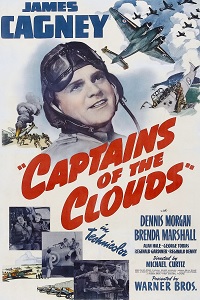
Captains of the Clouds is a 1942 American war film in Technicolor, directed by Michael Curtiz and starring James Cagney. It was produced by William Cagney, with Hal B. Wallis as executive producer. The screenplay was written by Arthur T. Horman, Richard Macaulay, and Norman Reilly Raine, based on a story by Horman and Roland Gillett. The cinematography was by Wilfred M. Cline and Sol Polito and was notable in that it was the first feature-length Hollywood production filmed entirely in Canada.

Fairchild Aircraft Ltd. was an aircraft manufacturer active at Longueuil, Quebec, Canada in the period 1920–50. It served as a subsidiary of the Fairchild Aircraft company of the United States.

Robert Bernard Cornelis Noorduyn was a Dutch-born American aircraft designer and manufacturer. He is best known for the Noorduyn Norseman, a legendary Canadian bush plane produced in the 1930s to 1940s and again in the 1950s.

The Fairchild F-11 Husky was a Canadian bush plane designed and manufactured in the post-Second World War era. Despite a promising design, a lack of a suitable powerplant hurt performance, and stiff competition from the de Havilland Beaver and de Havilland Otter designs meant the type never gained a solid foothold in the marketplace.
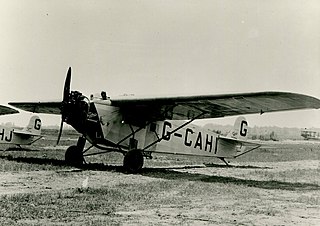
The Fokker Universal was the first aircraft built in the United States that was based on the designs of Dutch-born Anthony Fokker, who had designed aircraft for Germany during World War I. About half of the 44 Universals that were built between 1926 and 1931 in the United States were used in Canada. Among the famous pilots who flew the Fokker Universal were Punch Dickins and Walter Gilbert.

Canadian Airways Limited was a Canadian regional passenger and freight air service based in Winnipeg, Manitoba.

The Fairchild 82 and the 34-42 Niska were a family of utility aircraft produced in Canada in the mid-1930s, based on designs by Fairchild Aircraft Ltd. (Canada)'s parent company in the United States.

The Fairchild Super 71 was a Canadian parasol-mounted high-wing monoplane cargo aircraft built by Fairchild Aircraft Ltd. (Canada). The Super 71 was an entirely new design that was one of the first purpose-built civilian bush planes for use in remote and northern locales in Canada.

The Fokker Super Universal was an airliner produced in the United States in the late 1920s by Fokker America, an enlarged and improved version of the Fokker Universal, fitted with cantilever wings and an enclosed cockpit. It was also called the Model 8. It was subsequently also manufactured under license in Canada, and in Japan as the Nakajima–Fokker Super Universal and for the IJAAF as the Nakajima Ki-6 and later in the puppet state of Manchukuo as the Manshū Super Universal. It was used on the Byrd Antarctic expedition and was one of the most produced of the Fokker America models.
Francis Roy Brown was a politician in Manitoba, Canada. He served in the Legislative Assembly of Manitoba as a Liberal-Progressive from 1953 to 1958.
Ontario Central Airlines was a Canadian airline headquartered in Kenora, Ontario. It was founded in 1947 and served the Kenora District. It operated a wide range of aircraft, ranging from outdated passenger planes like the Douglas DC-3 to small bush planes like the Noorduyn Norseman.
Air Fecteau was an airline that operated primarily in Quebec, Canada.

Bush Pilot is a 1947 Canadian-American drama film directed by Sterling Campbell. The film, produced by Campbell's Dominion Productions, was noted for being one of the first full-length feature films outside Quebec in which a Canadian production company held the primary role.

Northway Aviation Ltd is a Canadian bush airline providing scheduled and charter passenger and freight service from St. Andrews Airport, St Andrews, Manitoba, Canada utilizing both wheel and float equipped aircraft.
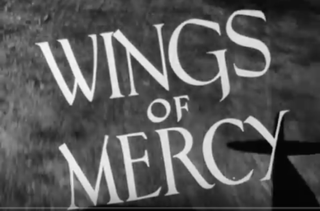
Wings of Mercy is a 21-minute 1947 Canadian documentary film made by the National Film Board of Canada (NFB), written, directed and produced by the team of Evelyn Spice Cherry and her husband, Lawrence. The film describes the formation and operational use of the Saskatchewan Air Ambulance service. The NFB production was later re-edited into a shorter, 11-minute film, Mercy Flight, released in 1948.
